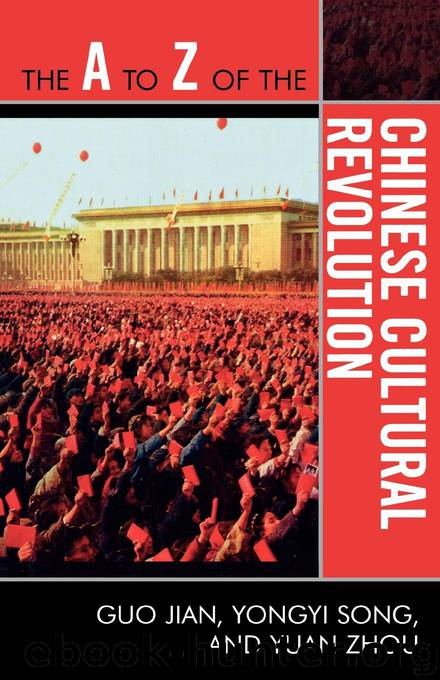The A to Z of the Chinese Cultural Revolution by Guo Jian & Yongyi Song & Yuan Zhou

Author:Guo Jian & Yongyi Song & Yuan Zhou
Language: eng
Format: epub
Publisher: Scarecrow Press
Published: 2006-03-14T16:00:00+00:00
– N –
NANJING 12 FEBRUARY COUNTERREVOLUTIONARY CASE 1970. A wrongful case against a group of students in Nanjing for their protest against the “One Strike and Three Antis” campaign and their opposition to Lin Biao and Jiang Qing. This case was related to another unjust verdict in Nanjing: on 12 February 1970, when the “One Strike and Three Antis” campaign was just beginning, a young man named Jin Chahua became the first victim of the campaign and was executed in Nanjing because of his critical views of the Cultural Revolution and his efforts as an organizer of a Marxism-Leninism study group. Sympathizing with Jin’s views and outraged by his execution, Chen Zhuoran, a student at the Nanjing No. 8 Middle School, and some of his friends and fellow students went out on the night of Jin’s execution and posted on the streets six slogans including “Immortal is the martyr Jin Chahua,” “We need true Marxism,” “Down with Lin Biao,” and “Down with Jiang Qing.” In April 1970, Chen and his friends were arrested for their involvement in the “12 February counterrevolutionary case.” On 28 April 1970, a public trial was held, during which Chen Zhuoran’s death sentence was pronounced; Su Xiaobin, one of Chen’s friends, was sentenced to 15 years in prison. Wang Maoya, another student involved, was driven insane by the harsh measures and eventually committed suicide. On 13 May 1981, the Nanjing Intermediate People’s Court redressed the case and pronounced all of the verdicts unjust.
NANJING INCIDENT (1976). A spontaneous political movement in the form of a public mourning for the late Premier Zhou Enlai as well as a mass protest against the Jiang Qing group took place in Nanjing, Jiangsu Province, in late March and early April 1976. The immediate cause of the protest was a series of slanders in the media against Zhou Enlai, especially an implicit reference to Zhou as a capitalist-roader supporting Deng Xiaoping in an article published in the 25 March issue of ultraleftists-controlled Shanghai newspaper Wenhui Daily. While careful readers across China were enraged by such insinuations and writing and calling the newspaper to protest, people in Nanjing were the first to be organized and take to the street. With the approach of the traditional Qingming Festival (4 April in 1976)—a day to visit cemeteries and remember the dead—numerous wreaths honoring the late premier were made and placed in the Yuhuatai Cemetery of Revolutionary Martyrs at Meiyuan in the suburbs of Nanjing.
On 28 March, more than 400 students and teachers from Nanjing University held Zhou’s portrait, carried a flower wreath, and marched through Nanjing’s busiest streets to Meiyuan. The traffic police gave them green lights, while all vehicles made way for them. More and more people joined the march while a huge number of pedestrians stood silently along the streets. The next day, college students posted or painted slogans on the walls in the city and on the trains passing through Nanjing—slogans commemorating Zhou, protesting against Wenhui Daily, and denouncing the Jiang Qing group although without mentioning names.
Download
This site does not store any files on its server. We only index and link to content provided by other sites. Please contact the content providers to delete copyright contents if any and email us, we'll remove relevant links or contents immediately.
| Africa | Americas |
| Arctic & Antarctica | Asia |
| Australia & Oceania | Europe |
| Middle East | Russia |
| United States | World |
| Ancient Civilizations | Military |
| Historical Study & Educational Resources |
The Sympathizer by Viet Thanh Nguyen(4099)
The Rape of Nanking by Iris Chang(4025)
World without end by Ken Follett(3347)
Ants Among Elephants by Sujatha Gidla(3282)
Blood and Sand by Alex Von Tunzelmann(3061)
Japanese Design by Patricia J. Graham(3006)
City of Djinns: a year in Delhi by William Dalrymple(2438)
Foreign Devils on the Silk Road: The Search for the Lost Treasures of Central Asia by Peter Hopkirk(2389)
Inglorious Empire by Shashi Tharoor(2349)
The Queen of Nothing by Holly Black(2326)
India's Ancient Past by R.S. Sharma(2307)
In Order to Live: A North Korean Girl's Journey to Freedom by Yeonmi Park(2305)
Tokyo by Rob Goss(2295)
India's biggest cover-up by Dhar Anuj(2251)
Tokyo Geek's Guide: Manga, Anime, Gaming, Cosplay, Toys, Idols & More - The Ultimate Guide to Japan's Otaku Culture by Simone Gianni(2244)
The Great Game: On Secret Service in High Asia by Peter Hopkirk(2231)
Goodbye Madame Butterfly(2164)
Batik by Rudolf Smend(2010)
Living Silence in Burma by Christina Fink(1988)
